This is a guide to the different types of serial killers.
In a previous article, we wrote about how serial killers are often classified as organized or disorganized.
However, these two categories describe their characteristics, not their motives. Furthermore, having two categories isn’t enough. Human beings are complex creatures with different wants and needs.
Therefore, there is a real need to break these serial killers down into different “types” that describe their motivations. In other words, “What drives them to kill?” “What makes them tick?”
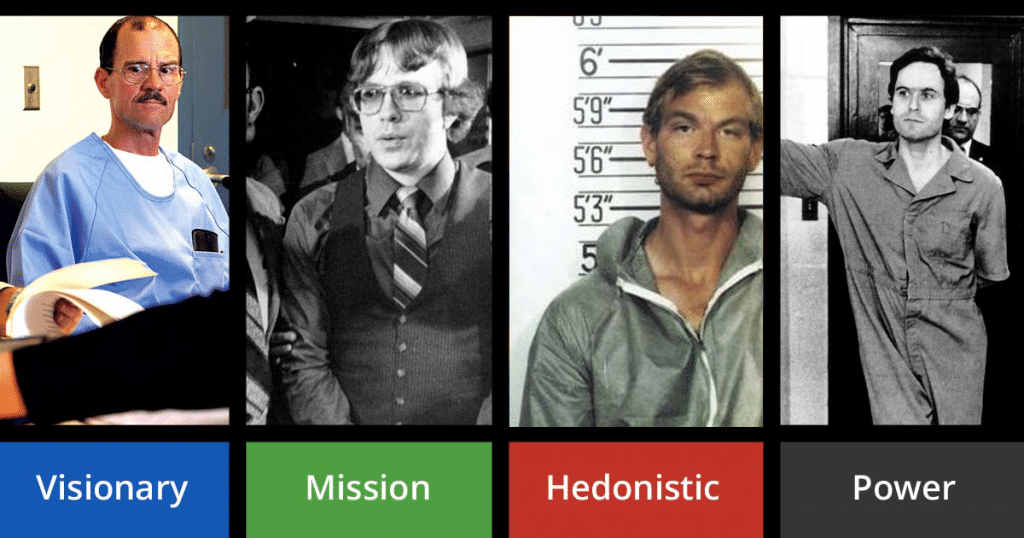
Form left to right: Herbert Mullin, Joseph Paul Franklin, Jeffrey Dahmer and Ted Bundy.
What are the different types of serial killers?
Currently, there are four main types of serial killers. These are Visionary, Mission-oriented, Hedonistic and Power / Control.
These types are based on their motivations for carrying out their crimes. For example, a Hedonistic killer might kill for his own sexual gratification. On the other hand, a Visionary killer could murder people because he believes that God is telling him to do so.
As you can see, there are various reasons why serial killers kill.
Another point worth noting is that these motivations will often overlap. i.e. A killer can fall into more than one category. As I stated above, human beings are complex creatures. Therefore, we must be cautious about trying to shoehorn every killer into one specific type or category.
Having said that, the four main types of serial killers can be summed up as follows:
- Visionary: Believes that a person or entity is commanding him to kill. Most likely suffering from psychosis.
- Mission-oriented: Kills in order to “rid” society of a certain group.
- Hedonistic: Commits his acts for his own personal pleasure. For example, rape, torture or money.
- Power/control: Fantasizes about having power and seeks to dominate and control his victims.
Furthermore, the Hedonistic type can be broken down into three subcategories called Lust, Thrill and Comfort.
What is a Visionary serial killer?
A Visionary serial killer is someone who kills because they believe that a person or entity is commanding them to do so.
More often than not, these killers are disorganized and suffering from psychosis. This psychosis causes them to lose touch with reality. In other words, they are often unable to tell the difference between what is real and what is not. They can suffer from hallucinations and hear voices that aren’t real. They can also hold delusional beliefs. For example, they might believe that people are out to get them. Or that their thoughts are being read by someone else.
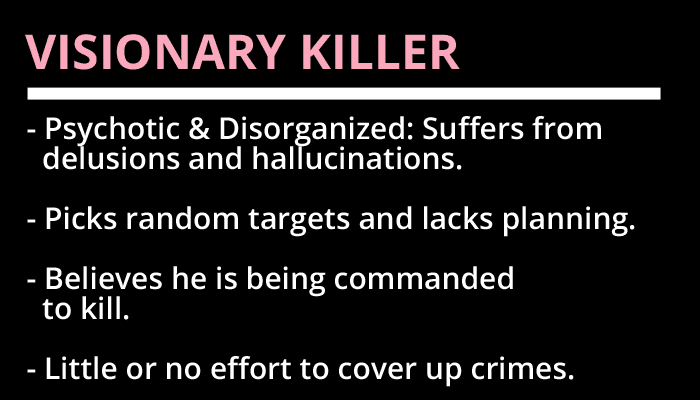
In most cases, a Visionary killer will not specifically target their victims. They will not pick a type or stalk their victims. As a result, their crimes will seem “random”. This can make it difficult for law enforcement to connect their murders together.
They will also make little or no effort to cover up their crimes. Nor will they put much planning into the attack.
Example of a Visionary serial killer.
Herbert Mullin is a good example of a Visionary serial killer. Mullin killed 13 people between 1972 and 1973 as a “blood sacrifice”.
His delusions led him to believe that a massive earthquake would strike California if nature did not receive this sacrifice. He also heard voices in his head that warned him about the event and commanded him to kill.
Mullin believed that the war in Vietnam had caused enough to deaths to appease nature and prevent the earthquake. However, by the end of 1972, the war was in its final stages. US forces had been reduced and the United States was planning to exit the conflict. As a result, Mullin felt as though he needed to step up and “compensate” for the lack of deaths.
In other words, in his mind, it was now up to him to prevent this earthquake.
Another example of a Visionary serial killer is Richard Chase. Between 1977 and 1978, Chase murdered 13 people. His reason for doing this? He believed that his blood was turning into powder and that he needed to replenish it by drinking the blood of others.
What is a Mission-orientated serial killer?
A Mission-orientated serial killer is someone who kills in order to “rid” society of a specific group of people.
For example, they might be racist against a certain ethnicity or religion. Or they might target sex workers or homosexuals.
These kinds of killers often believe that they are doing society a favor. In their heads, they have a purpose. It is their mission to kill these people. As a result, they typically won’t stop until they have been killed or caught by law enforcement.
An important point to note is that they are not psychotic. Unlike the Visionary killer, the Mission-orientated killer is not out of touch with reality. He does not suffer from hallucinations or delusions. God or some other entity is not commanding him to commit these acts. i.e. His decision to kill was a decision that he made all by himself.
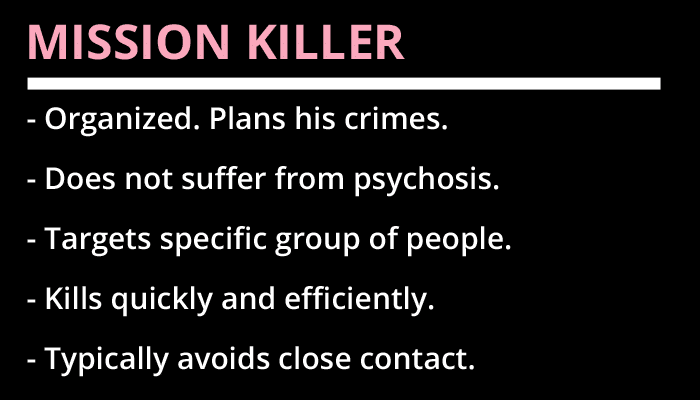
Usually, this type of serial killer tends to be organized. They plan their crimes and can live a perfectly normal life. In addition, they tend to kill their victims quickly. For example, they might use a gun because it is quick and efficient. There will be no attempts to “prolong” the kill or get further enjoyment out of it. As a result, the crime scene will contain no signs of sadism or torture.
Mission killers tend to put distance between themselves and their victims. Unlike Hedonistic and Power/control killers, mission killers will often choose a gun over using a knife or their hands.
Mission-orientated serial killers can be meticulous and obsessive. Feelings of revenge and hatred are often a driving factor behind their crimes. They are getting back at a part of society. In most cases, they tend to stick to their own geographical area.
Example of a Mission-orientated serial killer.
Joseph Paul Franklin is a good example of a Mission-orientated serial killer.
Between 1977 and 1980, Franklin targeted black and Jewish people. He believed that race mixing was a crime against God. This led him to focus most of his ire towards interracial couples.
For example, in June of 1980, Franklin used a high powered rifle to kill Arthur Smothers and Kathleen Mikula. He carried out this attack because Smothers was a black man and Mikula was a white woman.
On the morning of the shooting, Franklin took up a concealed position in the woods and waited for a target.
As you can see, Franklin fits the “profile” of a Mission-orientated killer pretty well:
- His attacks were focused on a specific group of people. In this case, it was interracial couples.
- He planned his murders.
- He also chose a “quick” method of killing.
However, there is one thing that Franklin did that does not fit the profile of a mission killer.
Typically, mission killers tend to stick to their own geographical area. However, in Frankin’s case, he was a drifter who roamed around the East Coast. In fact, many of his murders took place in different states.
As I noted above, it is actually pretty unlikely that a killer will fit every part of the profile. It is naive to believe that serial killers can be separated into categories so easily. Instead, the facts of the case must be “weighed up”. You have to think of these categories as a “scale” instead of a simple yes or no.
What is a Hedonistic serial killer?
A Hedonistic serial killer is a type of serial killer who kills for pleasure. They can be driven by sex, the “thrill of the kill” or money.
Hedonistic serial killers can be broken down into three subcategories. These are Lust, Thrill and Comfort.
What is a Lust killer?
A Lust killer is a serial killer who rapes, mutilates and kills for his own sexual gratification. In other words, the act of raping, torturing and doing unspeakable things to someone’s body gives him intense feelings of pleasure.
Lust killers can fantasize about committing these crimes for years before they pick up the courage to commit their first murder. In many cases, this violent fantasy will dominate their thoughts to the point that it becomes a deep-seated psychological need.
Once a lust killer commits his first murder, this “part of him” can take over his life. As time goes on, he might require more stimulation in order to relive the “highs” of his first couple of kills. As a result, the time between each murder may continue to get shorter and shorter as he struggles to control his impulses.
These kinds of serial killers tend to use weapons that put them in close contact with the victim. For example, they may use a knife or strangle the victim with their hands. Unlike the mission killer, the Lust killer requires close contact.
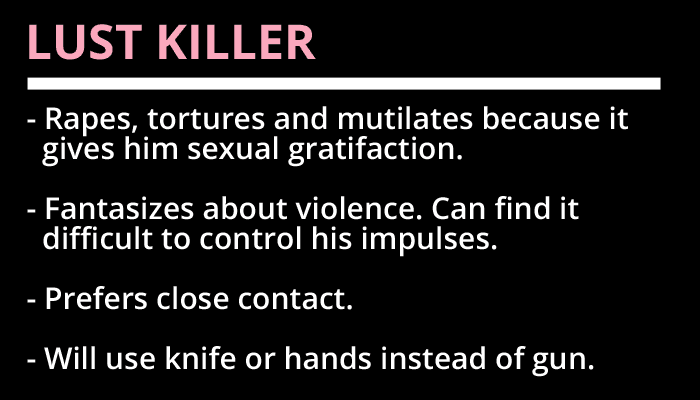
Lust killers will sometimes take trophies from their victims in order to remind themselves of their crimes. They can also return to the crime scene in order to relive the murder. Or worse, to mutilate the body and engage in necrophilia.
It is important to note that these crimes do not have to involve sexual intercourse. For example, the killer might not rape his victim because it is the murder itself that gives him sexual gratification. He may “get off” on torturing his victim and mutilating their body. As a result, intercourse with the victim may be a completely unnecessary act from his perspective.
What is a Thrill killer?
A “thrill killer” is a Hedonistic serial killer who gets a thrill out of murdering people. For example, hunting their victim or seeing their terror may give them an adrenaline rush.
Witnessing their victim’s fear gives them a “high” that they find extremely pleasurable. In other words, the suffering of their victims excites them.
This is the type of killer who will murder someone just so they can know what it feels like. It is the act itself that motivates them.
Although thrill killers can appear normal and confident on the outside, they often have feelings of inadequacy and powerlessness. By carrying out such crimes, they can make themselves feel powerful. Especially if they manage to get away with it.
Because this type of serial killer gets a pleasure out of seeing their victims suffer, sadism can be a common factor in their crimes. For example, they may torture their victims, both physically and mentally. They might let their victim run so that they can chase after them. They might also verbally taunt them or go through extra steps in order to scare them.
Essentially, thrill killers feed off the response that they get from their victims.
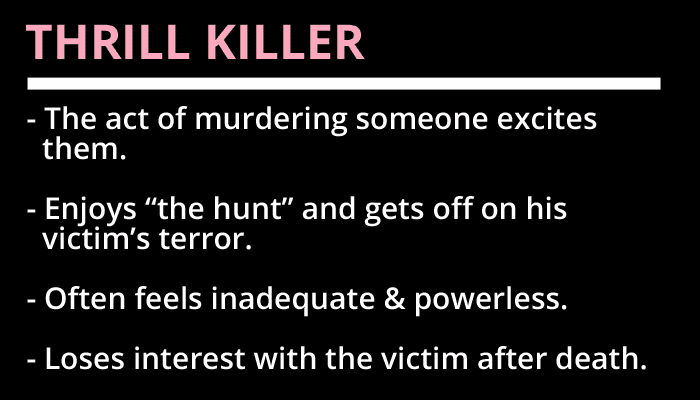
Although rape may be used as a “tool” to degrade and inflict pain on their victims, sex is not the primary motivator. Furthermore, close contact isn’t always a necessity. For example, the killer may get enough of a thrill out of the act by simply shooting his victim.
Once a thrill killer has murdered their victim, they will typically lose interest in them. This is because the deed is done and the victim can no longer give them a response. As a result, there are unlikely to be any signs that the body was mutilated after the killing.
What is a Comfort killer?
A Comfort killer is someone who kills for money or other material gains. For example, they might murder their spouse in order to receive an insurance payout. Or they might kill a sibling for the sake of an inheritance gain.
These killers are known to use poison to commit their crimes. Close contact is not a necessity. Nor are they likely to torture the victim or mutilate the body afterwards. The kill is simply a means to an end. In this case, that “end” is usually financial gain.
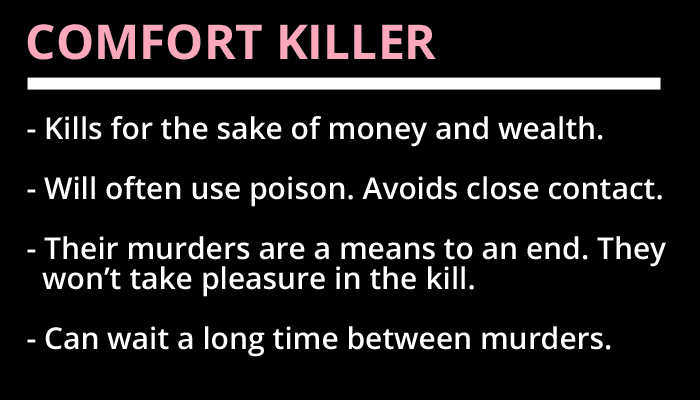
Most female serial killers tend to fall under this “Comfort (Profit)” category. In other words, if a woman becomes a serial killer, then it is likely that her main motivation for killing is money or wealth. This is why criminal profilers will often predict that Lust, Thrill and Power serial killers are male. From what we have seen, women are unlikely to kill for sexual gratification or power.
Having said that, it is important to note that not all Comfort killers are women. In fact, males still make up the vast majority of this category.
The Comfort serial killer can wait a lengthy time between murders. This is because killing isn’t an impulse or something that they particularly enjoy. It is simply a tool that allows them to achieve their goals.
What is a “Power/control” serial killer?
As the name suggests, a “Power/control” serial killer is someone who seeks to gain power and control over their victims.
This is the fourth and final category in our “types of serial killers.” It is also one of the most common types.
The “Power / control” killer seeks to dominate their victims. In a lot of cases, these men have feelings of inadequacy and powerlessness and are afraid of rejection. Many of them were also abused as children.
Dominating their victims and taking away their lives gives them a feeling of empowerment.
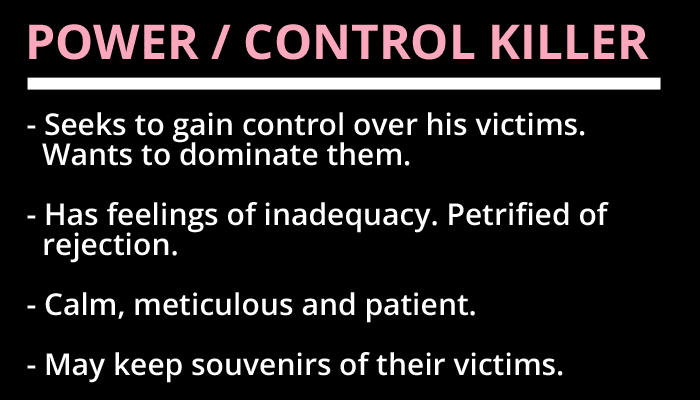
These kinds of serial killers are often calm, meticulous and patient. They also tend to be organized.
Although they may sexually assault their victims, this is not done for sexual pleasure. Unlike Lust killers, the “Power / control” killer uses sexual assault as a tool to exert power and control over their victims. It is the act of dominating someone and taking away their choice that gives them a high.
Even after the act of murder is done, the “Power / control” killer may continue to “control” his victim. For example, he might return to the body and mutilate it further. He might also engage in necrophilia. The act of keeping souvenirs that remind them of their victims is also common. For example, the killer could take photographs of his victims or keep pieces of their jewelry.
A souvenir allows the killer to relive the crime and fantasize about it. It also acts as a badge or token. In other words, it represents a life that they took.
He might even give this piece of jewelry to his partner and claim that he purchased it or found it. By doing this, he is essentially manipulating his partner into wearing something that he took from his victim.
These “types” of serial killers can overlap.
As I stated above, these categories can overlap. Especially the Power/control and Hedonistic types.
A killer can be a Power/control killer who also has certain characteristics of a Thrill killer. For example, he might commit his crimes in order to dominate his victims and exert control over them. That is his primary motivation for committing such acts. However, he might also taunt the police or the victim’s family, which is something that you’d expect from a Thrill killer.
Humans are complex. In a lot of cases, we don’t fully understand why we do certain things. As a result, categorizing serial killers into these different “types” can be prove to be difficult.